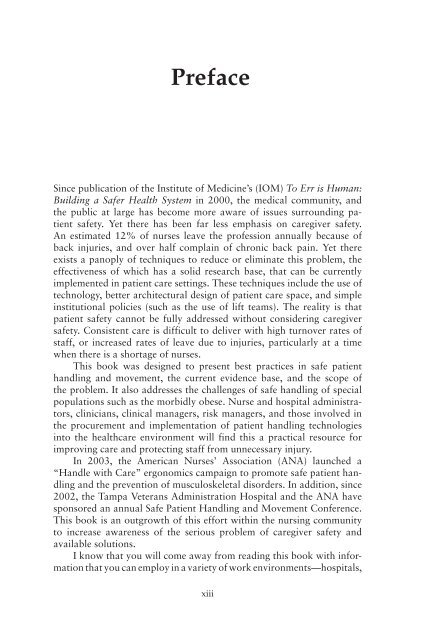Safe Patient Handling and Movement - Springer Publishing Company
Safe Patient Handling and Movement - Springer Publishing Company
Safe Patient Handling and Movement - Springer Publishing Company
You also want an ePaper? Increase the reach of your titles
YUMPU automatically turns print PDFs into web optimized ePapers that Google loves.
Preface<br />
Since publication of the Institute of Medicine’s (IOM) To Err is Human:<br />
Building a <strong>Safe</strong>r Health System in 2000, the medical community, <strong>and</strong><br />
the public at large has become more aware of issues surrounding patient<br />
safety. Yet there has been far less emphasis on caregiver safety.<br />
An estimated 12% of nurses leave the profession annually because of<br />
back injuries, <strong>and</strong> over half complain of chronic back pain. Yet there<br />
exists a panoply of techniques to reduce or eliminate this problem, the<br />
effectiveness of which has a solid research base, that can be currently<br />
implemented in patient care settings. These techniques include the use of<br />
technology, better architectural design of patient care space, <strong>and</strong> simple<br />
institutional policies (such as the use of lift teams). The reality is that<br />
patient safety cannot be fully addressed without considering caregiver<br />
safety. Consistent care is difficult to deliver with high turnover rates of<br />
staff, or increased rates of leave due to injuries, particularly at a time<br />
when there is a shortage of nurses.<br />
This book was designed to present best practices in safe patient<br />
h<strong>and</strong>ling <strong>and</strong> movement, the current evidence base, <strong>and</strong> the scope of<br />
the problem. It also addresses the challenges of safe h<strong>and</strong>ling of special<br />
populations such as the morbidly obese. Nurse <strong>and</strong> hospital administrators,<br />
clinicians, clinical managers, risk managers, <strong>and</strong> those involved in<br />
the procurement <strong>and</strong> implementation of patient h<strong>and</strong>ling technologies<br />
into the healthcare environment will find this a practical resource for<br />
improving care <strong>and</strong> protecting staff from unnecessary injury.<br />
In 2003, the American Nurses’ Association (ANA) launched a<br />
“H<strong>and</strong>le with Care” ergonomics campaign to promote safe patient h<strong>and</strong>ling<br />
<strong>and</strong> the prevention of musculoskeletal disorders. In addition, since<br />
2002, the Tampa Veterans Administration Hospital <strong>and</strong> the ANA have<br />
sponsored an annual <strong>Safe</strong> <strong>Patient</strong> <strong>H<strong>and</strong>ling</strong> <strong>and</strong> <strong>Movement</strong> Conference.<br />
This book is an outgrowth of this effort within the nursing community<br />
to increase awareness of the serious problem of caregiver safety <strong>and</strong><br />
available solutions.<br />
I know that you will come away from reading this book with information<br />
that you can employ in a variety of work environments—hospitals,<br />
xiii<br />
14108FM.indd 13 11/11/05 1:21:08 PM

















